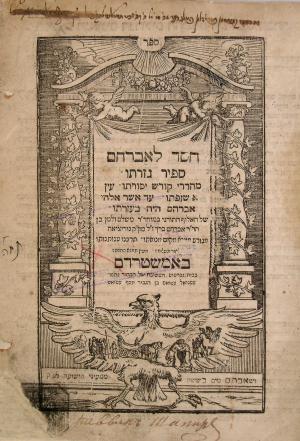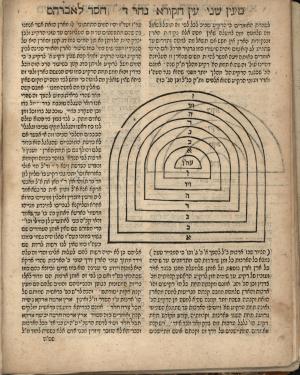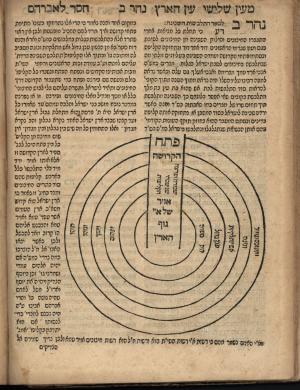Obj. ID: 38069
Jewish printed books Chesed le-Avraham by Avraham ben Mordechai Azulai, Amsterdam 1685

This text was prepared by William Gross: Kabbalistic discourses by R. Abraham ben Mordechai Azulai (c. 1570-1643). Chesed le-Avraham was printed independently in 1685 two locations, Amsterdam and Sulzbach. It is not clear which edition was printed first. Illustrated title page and Kabbalistic illustrations.
This Amsterdam edition contains an introduction by Azulai, in which he informs the reader that he was residing in Hebron when there was an outbreak of plague, forcing him to seek refuge in Jerusalem. When the plague reached Jerusalem he fled to Gaza where he wrote Chesed le-Avraham. It is named so for two reasons: to remember the goodness of the Lord in that he saved him from the plaque, and to teach that all who look into this work do kindness with him (Azulai) to merit and cause merit. This book was widely quoted in the following generations and in early Chassidic literature. Many quotes in musar books in the name of the "Holy Books" originate from this book. the last chapter Breichat Avraham is based on a variation of the printed version, which was printed in the book Tomer Devorah by the Ramak.
The Chida was one of his descendants [great-grandson], and in his book Shem HaGedolim he mentions "the Rabbi, the pious grandfather", and writes that he descended from one of the families of Castilian sages who fled to Fez after the Spanish Expulsion. "He travelled by ship to Caphutkia and debarked to dry land and left all their belongings in the ship. Immediately, a stormy wind arose and smashed the ship and everything drowned, sparing them their lives. In memory of this miracle, he signed his name in the shape of a ship". Some of his other works in Halacha and Kabbalah: Ahava BaTa'anugim on Mishnayot, glosses on the Levush, Or HaChama and Zoharei Chama.
Hida (Ma’arekhet Seforim het 95) is critical of this edition, noting that it is based on a faulty manuscript, is incomplete, and full of errors. This, in contrast to the Sulzbach edition, which was based on a complete and corrected manuscript (see B.1458).
Architectural title page with winged and trumpeting cherubim at top; below a large eagle spreads its wings, displaying a vignette of Jacob meeting Joseph. Kabbalistic diagrams.
Abraham ben Mordecai Azulai (c. 1570–1643) (Hebrew: אברהם בן מרדכי אזולאי) was a kabbalist of repute, author and commentator born in Fez, Morocco. In 1599 he moved to Palestine, experiencing many hardships along the way, and settled in Hebron, where he wrote a commentary on the Zohar entitled Kiryat Arba. The plague of 1619 drove him from his new home in Hebron to Gaza. It was there that he wrote his Chesed le-Avraham. He is considered one of the few Kabbalists that put into writing many teachings that were only passed down orally. His grandson was R. Hayyim Joseph David Azulai (”Hida”, 1724-1806).
Immanuel Athias took over the Hebrew section of his father, Joseph's, press in 1685, the year he issued this book. Although the father is more renowned, especially for his Bible editions, it was Immanuel who was responsible for the family's high repute in the world of Hebrew books. His four-volume edition of Maimonides' Mishneh Torah (1702), of which 1,150 copies were printed, was described by M. Steinschneider as "one of the most elegant and beautiful Hebrew editions to have ever appeared." His last issue was a Sephardic rite prayer book (1709). Much of Athias' printing material, which was highly regarded, became the property of the Proops family in 1761.
[5], 65, 28 leaves










